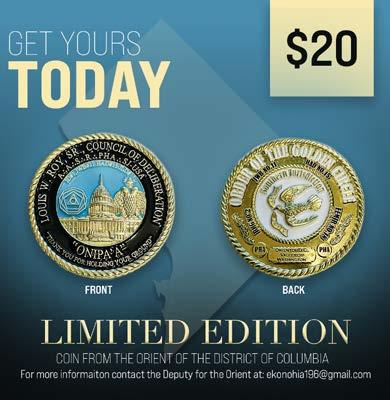
6 minute read
JONATHAN DAVIS
Written By SP Alonza T. Evans, 32°
The story of the Scottish Rite within Prince Hall Freemasonry begins in 1850 in Philadelphia, Pennsylvania. Count de Saint-Laurent of the Supreme Council of France conferred the degrees of the Scottish Rite, including the Thirty-third and Last Degree of Scottish Rite Freemasonry, upon David Leary, a prominent member of African Grand Lodge of Philadelphia, Pennsylvania.
Advertisement
In 1854, after receiving his patent of authority from the Supreme Council of France, investing him with the privileges and prerogatives of a Sovereign Grand Inspector General of the Active grade, he began training and conferring the degrees upon several worthy Brothers and established King David (Darius) Supreme Council with a full complement of elective and appointive officers In January 1856.
Edward M. Thomas of Felix Lodge No. 3, Union Grand Lodge of the District of Columbia petitioned the King David Council of Philadelphia, for the 33rd degree to be conferred on five representative Masons in D.C., and on May 5, 1856, the conferment was made, and a Supreme Council was established in Washington, DC.
By 1879 five Supreme Councils had been established near the eastern United States requiring those brothers to reconsider how they were establishing themselves. They held a series of meetings in New York City of all five (5) Supreme Councils in late 1880/early 1881. They then created a framework for a union.
This framework was responsible for the Articles of Union which established two Supreme Councils, the Supreme Council of the Northern Jurisdiction (PHA) and the United Supreme Council of the Southern Jurisdiction (PHA).
The constitutions for the Southern Jurisdiction were finalized and established in 1887.
Because of these agreements, the Washington DC Supreme Council was reorganized and renamed. The Illustrious Brothers of the District of Columbia bestowed the highest honor of respect for a man and his work in freemasonry and his masonic history on a brother they thought was instrumental to the progress of Freemasonry in Washington, DC. They named their newly constructed consistory, Jonathan Davis Consistory No. 1, United Supreme Council Ancient and Accepted Scottish Rite of Freemasonry, Prince Hall Affiliation, Southern Jurisdiction, USA
As this consistory has had a consistent existence for the ensuing 135 years, the question of who Jonathan Davis was has been raised without satisfactory answers as to his identity and what prompted the Illustrious brothers of the District of Columbia to name their consistory after him.
In the mid-1950’s noted African American historian, the Illustrious Charles H. Wesley, 330, undertook the task of trying to answer the unknown facts about who Jonathan Davis was. He completed a 15-page biography, The History of Jonathan Davis[1], which has some discrepancies but is still the most comprehensive attempt to unveil the history of the man Jonathan Davis. Illustrious Wesley also used much of this biography in an article published in the Crisis magazine in 1977.[2]
Jonathan Davis was born on April 10, 1820, in Fred erica, Delaware.[iii] He was known to practice herbal medicine and was listed as a druggist in several Directories published during his life. He was awarded an honorary MD status by the Electic Medical College of Pennsylvania in 1867. He was also known as a “civil activist” in Pennsylvania.
Jonathan Davis was a member of Widows Son Lodge No. 4 , African Grand Lodge of Pennsylvania, serving as its secretary. By 1845 he was appointed to a grand lodge committee that wrote a public rebuke of Hiram Grand Lodge, publishing the rebuke in the Public Ledger newspaper. He was later appointed to the African Grand Lodge committee which met with delegates from Hiram Grand Lodge to resolve the differences between the two bodies and pave the way for their consolidation into the African Grand Lodge in Pennsylvania.
June 18, 1845 Jonathan Davis is one of three men of a special committee of African Grand Lodge of Pennsylvania who signed a notice published in the Public Ledger newspaper of Philadelphia, declaring Hiram Grand Lodge clandestine.[4]
December 10, 1847, Jonathan Davis was appointed one of the five delegates of the African Grand Lodge of Pennsylvania to a joint committee with delegates from Hiram Grand Lodge of Pennsylvania to resolve the differences between the two grand lodges and pave the way for a consolidated Grand Lodge in Pennsylvania.[5]
1. June 29, 1849, Jonathan Davis signs a declaration on the status of the state grand lodge of New York by the National Grand Lodge as N.G.S Pro tem.[6]
2. The 1865 Triennial Session of the National Grand Lodge, Jonathan Davis was duly elected National Grand Secretary.[7]
3. July 1, 1874, PGM Dr. Jonathan Davis, Right Worshipful National Grand Secretary succumbed to his severe medical impairments.
4. Josiah H. Drummond, PGM of the Grand Lodge of Maine wrote an article dated July 4, 1874, which appeared in the Pacific Appeal newspaper, praising Jonathan Davis. Drummond stated, “I think that there is so much opposition to the National Grand Lodge that it will not exist for any length of time. Its Grand Secretary, Dr. Jonathan Davis, of Philadelphia, is a very efficient officer, and I judge that it is through his influence that the National Grand Lodge has held together so long.”[viii]

Jonathan Davis was well known among the brothers of Washington, DC. He was present with other representatives from African Grand Lodge of Pennsylvania at the organizing convention of Union Grand Lodge in the District of Columbia in March 1848. He was also present in the District of Columbia in 1856 helping Illustrious Edward Thomas establish the Supreme Council of Washington DC.
Jonathan Davis was present on June 8th, 1844, when three encampments met at a convention at Masonic Hall, Lombard Street, Philadelphia, Pa., and organized the First African Grand Encampment of North America. Davis was elected the grand encampment’s first Grand Recorder.
Jonathan Davis was present at the convention in the District of Columbia in his capacity of Grand Recorder when Simons Commandery, No. 13, now No. 1, and Henderson Commandery were char- tered in 1855, by the first African Grand Commandery of the United States of North America. Headquarters at Philadelphia.
He was also present in 1867 when Gethsemane Commandery, No. 16, now No. 3, was chartered. Knights Templars in the District of Columbia by the first African Grand Commandery of the United States of North America. Headquarters at Philadelphia,
When Jonathan Davis transitioned to his heavenly rewards on July 1, 1874, the masons of Washington DC. lost a friend and mentor. And when they helped organized the United Supreme Council of the Southern Jurisdiction (PHA), they named the first consistory of this jurisdiction after this great man, Jonathan Davis.
[1] The History
[2]
[3] Ibid, page 5
[4] The
[5] Ibid, page 53
[6] Ibid, page 51
[7] Ibid, page 66
[8] Pacific Appeal July 4, 1874

Sovereign Grand Inspector General Quincy G. Gant was born and raised in Washington DC in 1974 to Yvonne and Keith Gant. He matriculated through the DC School System, until High School when he then moved to Maryland and graduated from High Point High School. SGIG Gant’s Masonic travels began in 1997 when he joined Redemption Lodge #24. Prior to that, he studied and learned from his uncle, the late Wade Singleton, who was a Past Master of St James Lodge #61 in the State of New Jersey, who first told him what Freemasonry was and why he should look into joining. After researching the organization, Brother Gant asked a friend to vouch for him, which he did.
Upon joining the Masonic Fraternity, SGIG Gant immediately latched onto it and began to flourish. He was awarded Master Mason of the year by Worshipful Master Joseph T. Gatling the same year he joined. He then went on to serve the respective seats of the lodge receiving not only various awards from the lodge, but from the Most Worshipful Prince Hall Grand Lodge of the District of Columbia as well, the first of which was Senior Deacon of the Year in 2003.
After serving as Junior and Senior Warden, Bro. Gant was blessed and honored to serve as Worshipful Master in 2006. As Worshipful Master, he was elected as President of the Master’s and Wardens Council, as well as awarded Worshipful Master of the Year by Most Worshipful Grand Master Robert E. Wheeler.
After serving as Worshipful Master, Past Master Gant was appointed by Most Worshipful Grand Master J. Raymond Murray as his Worshipful Grand Director of Community Affairs. Worshipful Gant held that position for two years. This position was especially important to SGIG Gant because it gave him an opportunity to build relationships with the community and report on and participate in the Jurisdiction’s charitable activities that were being performed. In 2009, Most Worshipful Grand Master David A. McWilliams saw fit to place Past Master Gant in the line as Junior Grand Steward, beginning his path to Most Worshipful Grand Master of the Most Worshipful Prince Hall Grand Lodge of the Jurisdiction of the District of Columbia. For the next nine



